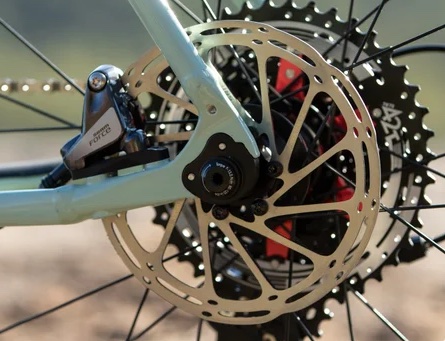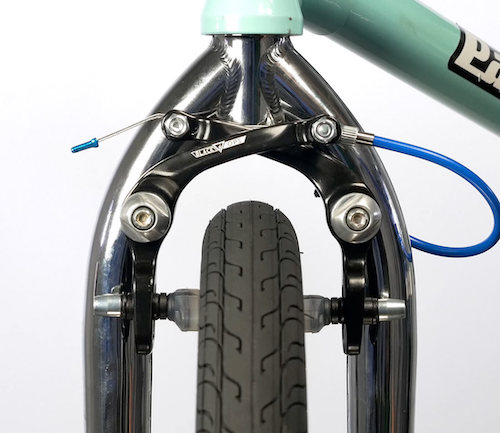Categories
New Blog
Tags
Disc brakes and rims brake are the most used on bikes. Do you know their advantages and disadvantages? Let's talk about it.
What is Disc brakes?

A disc brake is a braking system where the brake pads are contained in a caliper and create friction against a disc (rotor) that is attached directly to the wheel. This friction between the two surfaces slows the wheel.
Disc brakes sit at the center of each wheel and stop the bike by squeezing a brake pad against a rotor mounted around the hub. They feature superior stopping power, especially in sloppy conditions. Once found only on mountain bikes and a few road bikes, disc brakes are now found on all categories of bikes.
What is rim brakes?

Rim brakes, as their name suggests, stop the bike by squeezing two opposing brake pads against the rim of the bike wheel. The brake mechanisms are mounted on the frame somewhere near the upper part of the wheels.
Brakes is affected by weather conditions, user weight, braking duration and usage.Heat is a huge factor when it comes to braking, as the hotter the brakes become, the less effective they are.
This is a problem particularly on long descents where the rider will be using the brakes for extended periods. As such, heat dissipation has been at the forefront of brake innovation in recent years.
Disc brakes
Disc brakes have a level of modulation to them, which allows you to feather the brakes, and apply them lightly, hard, or somewhere in between. It’s just like using the brakes in your car – you can apply them gradually as you’re approaching a traffic signal, or you can apply them full-stop if something jumps onto the road in front of you.
They also generate significantly more stopping power than rim brakes, which comes in handy on steep descents and in races. Not only are disc brakes powerful, but they also require much less force to be applied at the lever, which is a great feature for kids, beginner-level and older riders.
Disc brakes also function well in all sorts of weather conditions such as rain, sleet, and mud. Variable weather conditions can hinder the performance of rim brakes, which puts you in a position where you don’t know how or when to apply your braking power in order to stop. This is one of the biggest reasons that cyclists choose disc brakes over rim brakes, especially during winter.
Off-road riders – from mountain bikers and cyclo-cross racers to gravel enthusiasts and bikepackers – love disc brakes because they allow for wider rims and more tyre clearance. Without the need for a brake caliper, there is more room for the wheel, and some disc brake road bikes can now accommodate up to 38mm wide tyres.
One final note: disc brake rotors can also be changed and customised for more or less stopping power. In general, a larger rotor equates to more stopping power, which is why we see the largest disc brake rotors on downhill mountain bikes and the smallest on hybrid bikes.
Rim brakes
The biggest advantage that rim brakes have over disc brakes is that they are lighter. With the parts, pads, components, and rotor altogether, a disc brake is typically a few hundred grams heavier than a comparable rim brake. Of course, there are super-lightweight disc brake setups out there, but they will cost you a pretty penny.
The pads of a disc brake are much smaller and more tightly adjusted than rim brakes, which is great for keeping water and grit out, but is also much more difficult to service. If the disc brake rotor gets bent or is slightly misaligned, many riders experience disc brake rub or squealing coming from their brakes. Needless to say, rim brakes don’t have this problem.
Maintainance
Disc brakes are notoriously fiddly to service, and no amount of YouTube tutorials can change that. Bleeding hydraulic disc brakes isn’t hugely complicated, but it requires much more of the home mechanic than a simple rim brake cable adjustment.
Without a work-stand and a decent number of tools, home repairs on disc brakes can become an onerous or even insurmountable challenge. The clearance between pad and rotor is minute and just a small wobble in the disc can cause significant noise.
Even with Shimano’s claim that the new 105 brakes boast 10% more clearance than their predecessors, disc brakes can be a thorn in the side of those looking to repair their own bikes and they put some people off all together.
Rim brakes, on the other hand, are the home mechanic’s best friend. Worn out pads? No worries – undo the grub screw, pop ’em out, new ones in, done. Barrel adjusters make tension adjustments easy, and even replacing cables is fairly simple once you know how.
Another contentious point is cleaning. Rim brakes excel in this area as, bar covering your wheels in GT85, they tend to withstand whatever cleaning products are thrown at them.
In the other corner, disc brakes are more delicate flowers. Getting general degreasers, chain lube or even oil picked up off the road on your disc rotors is a recipe for disaster and can often lead to the pads, and sometimes even the rotors themselves, needing to be replaced once contaminated.
As previously established, disc brakes provide more powerful braking, but with this comes extra strain on the bike itself. With more force going through the bike, particularly the fork, these areas must then be reinforced to handle it.
Because of the different requirements, bikes are normally designed from the ground up to accept either disc brakes or rim brakes, with just a handful of oddballs being compatible with both.
A benefit to the placing of disc brake calipers is that they allow for wider tyre clearances and this is one reason why discs are the default choice for gravel bikes.
Road rim brake calipers tend to limit how high and wide the tyres can sit, whereas disc brakes, mounted directly to the frame and fork, have no impact. Standard road rim brakes won’t usually accommodate tyres wider than 28mm, or 30mm at a push.
This also has benefits for the wheel design – wider rims that offer performance benefits can be used and, with no braking surface to consider and no braking heat to dissipate, they can be made lighter and, if desired, use a hookless design.
Though disc brakes originally entered mid-market, they quickly permeated the professional road scene. In 2021, the only team to be seen on rim brakes in the Tour de France was Ineos Grenadiers, but even they ditched them for the 2022 tour.
As such, fewer brands are producing their high-end bikes with a rim brake option, resulting in more of the cheaper models now featuring disc brakes as well.
Price cost
A rim brake set up will consist of the brake caliper, brake pads and a wheel with a machined braking surface.
Disc brakes are similar, with a caliper, brake pads and then a disc rotor fitted to a disc brake-compatible wheel. As individual components, rim brake parts are cheaper to buy, service and repair. Given the more intricate design, disc brake components and good performance disc brake framesets are typically more expensive.
Xiamen Tour de Cycling Industry&Trade Co.,Ltd. can supply you variety of good performance disc brake road carbon fibre frames and rims brake road frameset. Please freely to contact us to start your OEM project.
In conclusion
In terms of braking performance, disc brakes outperform rim brakes in almost every category. From variable weather conditions and steep descents, to quick stops in traffic and high-speed races, disc brakes are superior to rim brakes.
However, disc brakes can be finicky, expensive, and difficult to change and maintain. We’ve seen it many times in pro races, when a rider needs a wheel change and the mechanic struggles horribly to remove and exchange a wheel with disc brakes. Manufacturers are working to fix this problem, but it still persists. If you’re a dedicated racer, you will get a much quicker wheel change with rim brakes versus disc brakes.
Rim brakes are cheaper, easier to maintain at home, and often lighter than disc brakes, but they are notorious for poor performance in wet conditions, especially with carbon rims. This is because water builds up on the surface of the rim, and when the brake pads come in to make contact, they first have to displace the water before they can even get to the rim. This split-second delay between the application of the brake lever and the actual slowing of the rim is not something that's experienced with discs, but of course, with a bit of practice and experience, you can learn to safely use rim brakes in the wet.
However, it's worth noting that when you use your rim as a braking surface, it will wear down over time and you'll need to replace your wheels sooner than you would if you were using disc brakes.
The safety of disc brakes has been called into question since their advent, but most of the 'evidence' is anecdotal and circumstantial. Disc brakes heat up on long descents, and some riders have claimed to have been sliced open by a hot disc brake during a crash. But bike design and safety testing is better than ever, and disc brakes are not sharp. Their overall safety is improving at a rapid rate, and disc-brake-induced injuries are an extreme rarity.